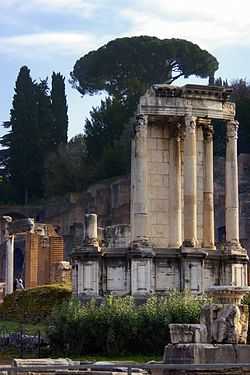Sacred fire of Vesta
Coordinates: 41°53′30″N 12°29′10″E / 41.891742°N 12.486176°E
| Sacred fire of Vesta | |
|---|---|
|
Hearth at the Temple of Vesta | |
| Location | Regione VIII Forum Romanum |
| Related | Vestal Virgin, Temple of Vesta |
 Sacred fire of Vesta | |
The sacred fire of Vesta was an sacred eternal flame in Ancient Rome. The Vestal Virgins, originally numbering two, later four and eventually six, were selected by lot and served for thirty years, tending the holy fire and performing other rituals connected to domestic life—among them were the ritual sweeping of the temple on June 15 and the preparation of foods for certain festivals. By analogy, they also tended the life and soul of the city and of the body politic through the sacred fire of Vesta, which was renewed every year on the Kalends of March.
The sacred fire burned in Vesta's circular temple, built in the Roman Forum below the Palatine Hill in pre-republican times. Among other sacred objects in the temple was the Palladium, a statue of Pallas Athena supposedly brought by Aeneas from Troy. The temple burned completely on at least four occasions and caught fire on two others. It was last rebuilt in 191 AD on the orders of Julia Domna, the wife of the emperor Septimius Severus.
The rites of Vesta ended in 394 by order of the Christian emperor Theodosius I. The fire was extinguished and the College of Vestals disbanded.
References
- Altheim, Franz (tr. Harold Mattingly): A History of Roman Religion (London: Methuen & Co., Ltd., 1938)
- Fowler, W. Warde The Roman Festivals of the Period of the Republic: An Introduction to the Study of the Religion of the Romans (London: Macmillan & Co., 1899)
- Platner, Samuel Ball (as completed and revised by Thomas Ashby): A Topographical Dictionary of Ancient Rome (London: Oxford University Press, 1929) (e-text)
- Rose, H. J.: Religion in Greece and Rome (NY: Harper & Row, 1959)
- "Vesta". 1911 encyclopedia.
